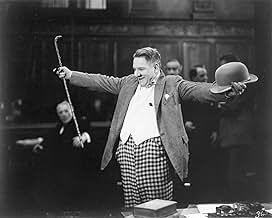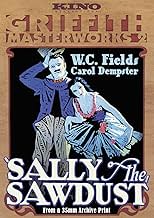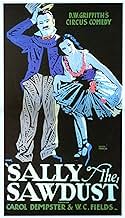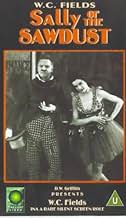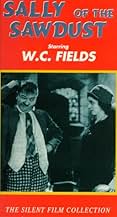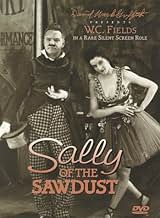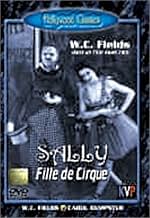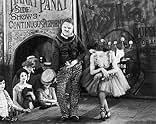NOTE IMDb
6,6/10
621
MA NOTE
La fille des Foster quitte sa famille pour suivre l'homme qu'elle aime et qui travaille dans un cirque.La fille des Foster quitte sa famille pour suivre l'homme qu'elle aime et qui travaille dans un cirque.La fille des Foster quitte sa famille pour suivre l'homme qu'elle aime et qui travaille dans un cirque.
- Réalisation
- Scénario
- Casting principal
- Récompenses
- 3 victoires au total
Glenn Anders
- Leon - the Acrobat
- (as Glen Anders)
William 'Shorty' Blanche
- Stooge
- (non crédité)
Steve Murphy
- Bandit
- (non crédité)
Jill Rainsford
- Bit Role
- (non crédité)
Tammany Young
- Yokel in the Old Army Game
- (non crédité)
Avis à la une
It's not often realised how strong the links were between silent cinema and the theatrical entertainment world of Vaudeville. W.C. Fields, like many Vaudeville comedians started out in pantomime – juggling, pratfalling and other staples of silent comedy. Fields would later add dialogue to his act and cultivate his now familiar persona, eventually progressing onto full-length comic dramas. Sally of the Sawdust, his first feature-length movie creates an odd shift in his career. It is adapted from his most recent stage hit Poppy, and yet the very different medium of pre-talkie cinema meant he had to rely upon the old routines from his pantomime days.
The picture sees him teamed up with pioneer director D.W. Griffith, now sadly long past his glory days. Griffith was never really much of a comedy director. He doesn't seem to have the confidence in his performers to let them do their stuff and allow the scenes to play out. Instead he seems stuck in the Keystone Cops mode of slapstick, which is always very frenetic, with lots of cuts. In a way this works out well because Griffith could at least direct a good action sequence, and scenes like the punch-up at the circus even if not very funny are at least nicely timed and escalated. Besides, even if the comedy fails the general air of irreverence stops the picture from getting too mawkish.
It is also rather nice to see Griffith returning to a simple, human story, as his usual epics with ride-to-the-rescue finales had been getting a little stale of late. Sally of the Sawdust more than any other harks back to the short films he made in the early teens for the way he focuses on individuals rather than wider social processes. There are some good examples of the way he builds up an emotional story. In the prologue, when the daughter is kicked out, we see the mother and father turn away from each other to face opposite walls, the camera well back in the large space, a perfect evocation of this cold, fractured household. And Griffith is still so good at expressing a feeling with the most delicate of close-ups, showing us for example Carol Dempster's hand clutching at the grass as she canoodles with Alfred Lunt. Acting performances vary immensely across Griffith's body of work, but the relatively restrained turns from Dempster and Elfie Shannon as old Mrs Foster add immensely to the poignant final scenes.
But what of W.C. Fields himself? We here and there see him going off into some bit of comedy business, but the truth is as a slapstick comic he is nothing really exceptional. He doesn't have the energy or flexibility to keep up with the wilder slapstick, and sequences like the one where he keeps knocking off his own hat just look out of place. Of course there is a lot more for him to do in Sally of the Sawdust, and Fields is at his funniest when simply acting out bits of the play (presumably kept intact from the original stage version) in his own characteristic manner. When trying to evade the police, he emerges from his hiding place wrapped in a cloak disguised as an Indian, and it is the way he strolls towards the camera, nonchalantly puffing on a cigar, that makes the moment funny. Still, there is clearly something missing from the act – the delivery, the voice, not to mention the opportunity to develop a curmudgeonly character without having to occasionally play the clown. It is no wonder his screen career never really took off until the arrival of the talkies.
The picture sees him teamed up with pioneer director D.W. Griffith, now sadly long past his glory days. Griffith was never really much of a comedy director. He doesn't seem to have the confidence in his performers to let them do their stuff and allow the scenes to play out. Instead he seems stuck in the Keystone Cops mode of slapstick, which is always very frenetic, with lots of cuts. In a way this works out well because Griffith could at least direct a good action sequence, and scenes like the punch-up at the circus even if not very funny are at least nicely timed and escalated. Besides, even if the comedy fails the general air of irreverence stops the picture from getting too mawkish.
It is also rather nice to see Griffith returning to a simple, human story, as his usual epics with ride-to-the-rescue finales had been getting a little stale of late. Sally of the Sawdust more than any other harks back to the short films he made in the early teens for the way he focuses on individuals rather than wider social processes. There are some good examples of the way he builds up an emotional story. In the prologue, when the daughter is kicked out, we see the mother and father turn away from each other to face opposite walls, the camera well back in the large space, a perfect evocation of this cold, fractured household. And Griffith is still so good at expressing a feeling with the most delicate of close-ups, showing us for example Carol Dempster's hand clutching at the grass as she canoodles with Alfred Lunt. Acting performances vary immensely across Griffith's body of work, but the relatively restrained turns from Dempster and Elfie Shannon as old Mrs Foster add immensely to the poignant final scenes.
But what of W.C. Fields himself? We here and there see him going off into some bit of comedy business, but the truth is as a slapstick comic he is nothing really exceptional. He doesn't have the energy or flexibility to keep up with the wilder slapstick, and sequences like the one where he keeps knocking off his own hat just look out of place. Of course there is a lot more for him to do in Sally of the Sawdust, and Fields is at his funniest when simply acting out bits of the play (presumably kept intact from the original stage version) in his own characteristic manner. When trying to evade the police, he emerges from his hiding place wrapped in a cloak disguised as an Indian, and it is the way he strolls towards the camera, nonchalantly puffing on a cigar, that makes the moment funny. Still, there is clearly something missing from the act – the delivery, the voice, not to mention the opportunity to develop a curmudgeonly character without having to occasionally play the clown. It is no wonder his screen career never really took off until the arrival of the talkies.
The plot of "Sally of the Sawdust" is the usual melodramatic stuff-- an orphan, rags-to-riches-- but the film rises above most silents thanks to four people:
This is not, of course, D. W. Griffith's masterpiece, but it does showcase his film-making savvy in full maturity. He uses all his innovations, which are techniques we take for granted now: close- ups, cross-cutting, a mobile camera, and the ability to modify acting from theatrical exaggeration to cinematic subtlety.
W. C. Fields also showcases his skills-- not his signature gruff delivery, but his remarkable dexterity as a physical comedian. He does a few inventive juggling acts, cut too short to be fully appreciated, and some very deft pickpocketing, but it seems that every prop that comes within reach gets manipulated for comic effect-- hat, cane, car roof, dog, cash. He's a joy to behold.
Much has been said against Carol Dempster as an actress, but not by me. She was 22 at the time, playing a teenager, and her combination of grace and awkwardness is engaging, particularly when she dances. She's not a beauty-- though she's positively luminous in the scene where she's gussied up like a Talmadge sister-- but her plainness enhances her simple affection for Fields, her guardian.
Finally, there is Alfred Lunt in one of his rare film roles, as a dashing leading man. He and his British wife Lynne Fontane (a lavender marriage) made one talkie together-- a wonderfully funny one, "The Guardsman," in 1931-- after which they quit movies forever for the Broadway stage, where they reigned from 1923 to 1957. So famous and powerful were they that they would only accept theatrical contracts which allowed them to work together. As for movies, Fontanne wrote to the Hollywood producer who tried to lure them back with huge flippin' wadges of cash, "We can be bought, but we cannot be bored."
This is not, of course, D. W. Griffith's masterpiece, but it does showcase his film-making savvy in full maturity. He uses all his innovations, which are techniques we take for granted now: close- ups, cross-cutting, a mobile camera, and the ability to modify acting from theatrical exaggeration to cinematic subtlety.
W. C. Fields also showcases his skills-- not his signature gruff delivery, but his remarkable dexterity as a physical comedian. He does a few inventive juggling acts, cut too short to be fully appreciated, and some very deft pickpocketing, but it seems that every prop that comes within reach gets manipulated for comic effect-- hat, cane, car roof, dog, cash. He's a joy to behold.
Much has been said against Carol Dempster as an actress, but not by me. She was 22 at the time, playing a teenager, and her combination of grace and awkwardness is engaging, particularly when she dances. She's not a beauty-- though she's positively luminous in the scene where she's gussied up like a Talmadge sister-- but her plainness enhances her simple affection for Fields, her guardian.
Finally, there is Alfred Lunt in one of his rare film roles, as a dashing leading man. He and his British wife Lynne Fontane (a lavender marriage) made one talkie together-- a wonderfully funny one, "The Guardsman," in 1931-- after which they quit movies forever for the Broadway stage, where they reigned from 1923 to 1957. So famous and powerful were they that they would only accept theatrical contracts which allowed them to work together. As for movies, Fontanne wrote to the Hollywood producer who tried to lure them back with huge flippin' wadges of cash, "We can be bought, but we cannot be bored."
I put off watching SALLY OF THE SAWDUST for years. Comedy was never Griffith's best genre and the 1920s were not his best decade. However, it turned out to be better than I expected, though that might be more because of WC Fields than anything else. He's funny, though decidedly lacking the misanthropic edge he had in his great 1930s work (the man warmly hugs a child in an early scene so you know you're not dealing with pure Fields here). The story is a 1920s take on Dickens' style melodrama: an eccentric con-man tries to reunite his adopted daughter with her rich relatives. The plot is stretched out, but there are charming episodes throughout and I was never bored.
Carol Dempster is quite mixed. I tend to find her unremarkable in most of her work and she only tended to shine in less glamorous/winsome roles (see ISN'T LIFE WONDERFUL for a genuinely great performance from her). Here, she veers between outright badness and inspired in what might be the most uneven performance of her short career. It often does not feel like she's playing a character so much as employing several facial tics repetitively in front of the camera: she winks, she coos, she does little dancing motions. It's supposed to come off as peppy but it often grates. Her emotional scenes are disastrous, complete with shameless mugging. However, Dempster excels in the physical scenes, like when she escapes a courthouse through a high window or when she's interacting with an elephant. I maintain that Dempster was best at playing active, everyday characters and not the Victorian girl-women Griffith liked to populate his movies with.
SALLY OF THE SAWDUST was one of Griffith's last films and is quite unlike anything else in his filmography. It's definitely worth seeing, though if you've never seen a silent movie before, I would not make this one your first.
Carol Dempster is quite mixed. I tend to find her unremarkable in most of her work and she only tended to shine in less glamorous/winsome roles (see ISN'T LIFE WONDERFUL for a genuinely great performance from her). Here, she veers between outright badness and inspired in what might be the most uneven performance of her short career. It often does not feel like she's playing a character so much as employing several facial tics repetitively in front of the camera: she winks, she coos, she does little dancing motions. It's supposed to come off as peppy but it often grates. Her emotional scenes are disastrous, complete with shameless mugging. However, Dempster excels in the physical scenes, like when she escapes a courthouse through a high window or when she's interacting with an elephant. I maintain that Dempster was best at playing active, everyday characters and not the Victorian girl-women Griffith liked to populate his movies with.
SALLY OF THE SAWDUST was one of Griffith's last films and is quite unlike anything else in his filmography. It's definitely worth seeing, though if you've never seen a silent movie before, I would not make this one your first.
Well done melodrama that tells the story of Sally, tomboy dancer in the circus, raised by sideshow performer McGargle (played by W.C. Fields), he of the top hat, little mustache, checkered pants, and proficiency as juggler, pickpocket, and runner of carnival con games like Three Card Monte and the Old Shell Game. McGargle has raised Sally, who worships him as her "real father" since Sally's mother (kicked out of her home by her father, a judge, when she married a "circus man") died and left Sally orphaned. Sally is feisty and loyal to McGargle no matter what he gets up to - but McGargle seems to feel a bit of guilt over keeping her in the circus instead of with her own family all these years. When they end up performing in a carnival in the town where her wealthy grandparents live, McGargle uses the opportunity to "investigate" Sally's real family, with the idea that he may restore her to them. But grandfather the judge takes an immediate disliking to Sally 'cause he doesn't like a "show girl" - what a stern, narrow-minded man he is, a real piece of work that guy! And meanwhile Sally is busy being pursued by a handsome and rich young man, son of the man who helped grandpa get his riches.
This is a very good film with a few laughs here and there and a sort of odd editing style (I don't know how to describe this other than it shows long shots, then sort of jumps back a few seconds or changes angle suddenly as a close up is shown). Carol Dempster, who plays Sally, is delightful here - quite cute and comical in her performance. W.C. Fields, even without his famous voice, is very funny - just the way he moves and his amusing, comical reactions to things (like a small dog seen in one funny scene), we even see him juggling briefly in this. I love the few peeks at the old-fashioned circus and carnival that is shown here. The print of this featured on the DVD is very nice looking, tinted a light sepia tone, and the piano score for this is really excellent, performed by Philip Carli based on the original cue sheets.
This is a very good film with a few laughs here and there and a sort of odd editing style (I don't know how to describe this other than it shows long shots, then sort of jumps back a few seconds or changes angle suddenly as a close up is shown). Carol Dempster, who plays Sally, is delightful here - quite cute and comical in her performance. W.C. Fields, even without his famous voice, is very funny - just the way he moves and his amusing, comical reactions to things (like a small dog seen in one funny scene), we even see him juggling briefly in this. I love the few peeks at the old-fashioned circus and carnival that is shown here. The print of this featured on the DVD is very nice looking, tinted a light sepia tone, and the piano score for this is really excellent, performed by Philip Carli based on the original cue sheets.
From a modern prospective, this is a most underwhelming film. Carol Dempster (as Sally) would seem, athleticism being one of her strengths, to be a natural choice to play a circus performer; she is, however, mostly unremarkable. W.C. Fields (as Professor McGargle) is more graceful; however, without his distinctive voice, he is somewhat disappointing. And, Alfred Lunt (as Peyton Lennox), known for his brilliant stage presence, is difficult to appreciate. Of the three, Mr. Fields is the most watchable.
The breathtaking beauty of earlier D.W. Griffith-directed films is noticeably absent. While some of the shots are lovely, nothing equals the artfulness evident throughout many past Griffith efforts. "Sally of the Sawdust" is beautifully preserved (if only all Griffith prints were as well preserved); and, it is an enjoyable comedy (certainly more so in 1925). It was adapted from Dorothy Donnelly's popular play "Poppy" (1923), with Madge Kennedy and W.C. Fields. It was re-filmed as "Poppy" (1936), with Rochelle Hudson and W.C. Fields. Norma Talmadge's popular film was an altogether different "Poppy" (1917), and did not co-star W.C. Fields.
***** Sally of the Sawdust (8/2/25) D.W. Griffith ~ Carol Dempster, W.C. Fields, Alfred Lunt
The breathtaking beauty of earlier D.W. Griffith-directed films is noticeably absent. While some of the shots are lovely, nothing equals the artfulness evident throughout many past Griffith efforts. "Sally of the Sawdust" is beautifully preserved (if only all Griffith prints were as well preserved); and, it is an enjoyable comedy (certainly more so in 1925). It was adapted from Dorothy Donnelly's popular play "Poppy" (1923), with Madge Kennedy and W.C. Fields. It was re-filmed as "Poppy" (1936), with Rochelle Hudson and W.C. Fields. Norma Talmadge's popular film was an altogether different "Poppy" (1917), and did not co-star W.C. Fields.
***** Sally of the Sawdust (8/2/25) D.W. Griffith ~ Carol Dempster, W.C. Fields, Alfred Lunt
Le saviez-vous
- AnecdotesD.W. Griffith had good reason not to use the name or title "Poppy" for this movie -a movie titled "Poppy" with a character by that name had come out in 1917.
- GaffesWhen Sally and Eustache were lying on the railway, after get wet on the train, you can clearly see that the railway ends on the film studio wall, right behind them.
- ConnexionsFeatured in W.C. Fields: Straight Up (1986)
Meilleurs choix
Connectez-vous pour évaluer et suivre la liste de favoris afin de recevoir des recommandations personnalisées
Détails
Box-office
- Montant brut aux États-Unis et au Canada
- 304 081 $US
- Durée1 heure 44 minutes
- Mixage
- Rapport de forme
- 1.33 : 1
Contribuer à cette page
Suggérer une modification ou ajouter du contenu manquant

Lacune principale
What is the English language plot outline for Sally, fille de cirque (1925)?
Répondre
